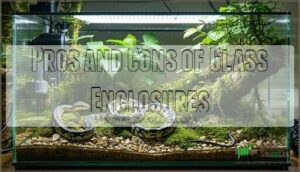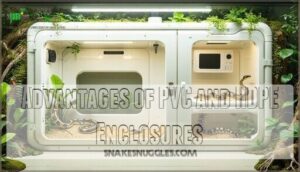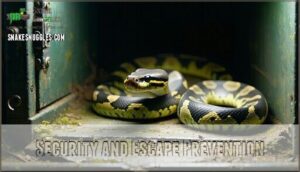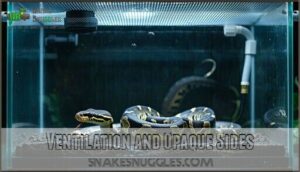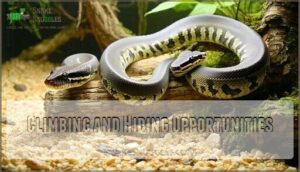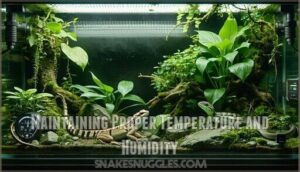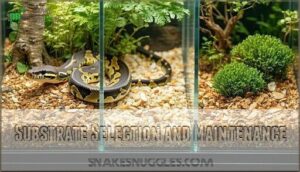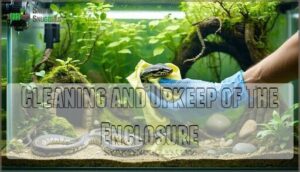This site is supported by our readers. We may earn a commission, at no cost to you, if you purchase through links.
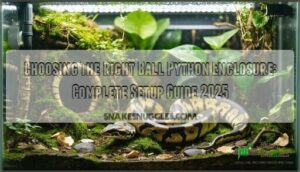
You’ll face the glass versus PVC decision—glass offers excellent visibility but PVC retains humidity better and weighs less. Essential features include secure locks, front-opening doors, proper ventilation, and opaque sides for security.
Temperature gradients from 75-80°F on the cool side to 95-104°F for basking, plus 50-60% humidity, complete the foundation. Smart substrate choices and strategic placement of hides make all the difference.
Table Of Contents
- Key Takeaways
- Choosing The Right Ball Python Enclosure Size
- Glass Tanks Vs. PVC Enclosures
- Essential Features for Ball Python Enclosures
- Maintaining Proper Temperature and Humidity
- Substrate Selection and Maintenance
- Cleaning and Upkeep of The Enclosure
- Frequently Asked Questions (FAQs)
- What type of enclosure is best for a ball python?
- What kind of habitat do ball pythons prefer?
- Can a cage be too big for a ball python?
- Is a 75 gallon tank good for a ball python?
- How often should I replace the water in my ball pythons dish?
- How do I know if my ball python is getting enough exercise?
- What should I do if my ball python refuses to eat in its new enclosure?
- Can ball pythons live together in same enclosure?
- How often should I upgrade enclosure size?
- Whats the best enclosure location in home?
- Conclusion
Key Takeaways
- Size your enclosure correctly – Use 10-gallon tanks for hatchlings, 20-gallon tanks for juveniles, and 40+ gallon tanks for adults, with females needing up to 75 gallons since they are larger.
- Choose between glass and PVC materials – Glass offers better visibility and ventilation, while PVC retains heat and humidity more effectively and weighs less.
- Maintain proper temperature gradients – Keep basking spots at 95-104°F, warm sides at 88-92°F, and cool sides at 75-80°F with 50-60% humidity levels.
- Focus on security and hiding spots – Install secure locks, front-opening doors, and provide tight-fitting hides on both warm and cool sides to prevent escapes and reduce stress.
Choosing The Right Ball Python Enclosure Size
Getting the right enclosure size is essential for your ball python’s health and happiness. You’ll need to match the tank dimensions to your snake’s age, sex, and length while avoiding spaces that are too cramped or overwhelmingly large, which is crucial for your snake’s health and happiness.
Minimum Size Requirements by Age and Sex
Your ball python’s enclosure size depends on its growth stages. Hatchling Enclosures need just 10 gallons for tiny snakes under six months.
Juveniles require 20-gallon dimensions as they reach 20-25 inches.
Adult Males thrive in 40-gallon tanks, while Adult Females need 55-75 gallons due to their larger size. Female Space requirements increase substantially since they can reach five feet.
Match enclosure size to your snake’s current development stage.
Enclosure Length Vs. Snake Length
Once you know the minimum size for each Growth Stage, focus on enclosure dimensions that match your snake’s length. Aim for an enclosure size that lets your python enjoy full Stretching Room, not just Coiled Comfort.
Use Size Ratios: enclosure length should be at least 0.9 times your snake’s length. Add Vertical Space for climbing, especially with adult ball pythons.
Risks of Overly Large or Small Enclosures
Getting the enclosure size wrong creates serious problems for your ball python’s health and happiness. Too small spaces cause stress, feeding issues, and growth stunting, while oversized enclosures overwhelm young snakes who need security.
Adult ball pythons require proper enclosure size requirements to prevent behavioral problems and security concerns in their ball python enclosure. You can use a ball python enclosure size calculator to determine the correct dimensions for your ball python’s health and to ensure the ball python enclosure is suitable.
Glass Tanks Vs. PVC Enclosures
When choosing between glass and PVC enclosures, you’ll find each material offers distinct advantages for your ball python’s health and your convenience.
Glass tanks provide excellent visibility and heat dissipation, while PVC enclosures excel at retaining humidity and offer easier front access for maintenance, which can be considered as easier front access for a better experience.
Pros and Cons of Glass Enclosures
Glass tanks offer excellent heat dissipation through their walls, creating natural temperature gradients your ball python needs. You’ll appreciate the clear visibility for monitoring your snake’s health and behavior. These enclosures naturally prevent mold growth through superior ventilation. However, customization options remain limited compared to other materials, and weight concerns make larger glass enclosures difficult to move.
| Advantages | Disadvantages |
|---|---|
| Superior heat dissipation creates natural gradients | Heavy weight makes relocation challenging |
| Crystal-clear visibility for health monitoring | Limited customization and modification options |
| Natural mold prevention through ventilation | Requires additional heating for humidity retention |
| Widely available with established sizing standards | Glass breakage risk during handling |
Advantages of PVC and HDPE Enclosures
Unlike glass enclosures that struggle with heat retention, PVC and HDPE materials excel at maintaining stable temperatures while offering superior customization options for your snake’s needs. These materials are also considered snake-safe for construction, ensuring a secure habitat.
| Feature | PVC/HDPE Advantage |
|---|---|
| Heat Retention | Superior insulation maintains temperature gradients |
| Durability | Lightweight yet impact-resistant construction |
| Customization | Easy drilling for ventilation and accessory mounting |
| Access | Front-opening design reduces escape risk |
| Maintenance | Non-porous surface resists bacteria and odors |
Recommended Brands and Sources
Quality brands matter when choosing your ball python enclosure. Vision Products and Vivarium Electronics lead PVC options, while Exo Terra dominates glass markets. Custom Cages offers personalized solutions. Online retailers like snakediscoverystore.com provide nationwide shipping, though local breeders and reptile shows offer hands-on inspection opportunities before purchasing your front-opening enclosure. A key aspect is selecting an enclosure that can maintain proper humidity levels.
| Category | Top Brands | Best Sources |
|---|---|---|
| Glass Brands | Exo Terra, Zoo Med | Petco, PetSmart, Online |
| PVC Brands | Vision Products, Vivarium Electronics | snakediscoverystore.com, customcages.com |
| Online Retailers | Animal Plastics, Custom Cages | Direct websites, reptile specialty stores |
| Local Options | Regional breeders, Custom builders | Reptile shows, breeder networks |
Essential Features for Ball Python Enclosures
Beyond size and materials, your ball python’s enclosure needs specific features to keep your snake secure and comfortable.
The right combination of security measures, ventilation, and enrichment elements creates an environment where your python can thrive naturally.
Security and Escape Prevention
Ball pythons are notorious escape artists who’ll test every weakness in their enclosure. You need multiple security layers to keep your snake safely contained and stress-free.
Your ball python will find every weak spot in their cage—secure every latch, lid, and opening
Essential security features include:
- Lid locks – Prevent your python from pushing open screen tops or loose-fitting lids
- Front-opening enclosures – Reduce escape opportunities compared to top-opening tanks with removable lids
- Secure hides – Provide tight-fitting shelters that won’t shift when your snake moves underneath
Ventilation and Opaque Sides
Proper ventilation prevents humidity buildup while maintaining necessary moisture levels in your enclosure. Glass enclosures need mesh tops for airflow importance, while PVC enclosures require strategically placed vents. Proper airflow can also prevent respiratory health issues.
Cover three walls with opaque material for visual security and stress reduction. This DIY solution helps your snake feel secure without compromising air circulation throughout the habitat.
Climbing and Hiding Opportunities
Your ball python needs both climbing branches and secure hides to thrive. Install sturdy branches at different heights for arboreal enrichment while providing tight-fitting hiding spots on both warm and cool sides.
These natural behaviors reduce stress substantially. Choose hides where your snake touches multiple sides simultaneously, mimicking wild burrows.
Nighttime exploration and muscle development are encouraged by climbing branches.
Visual Barriers and Enrichment
Creating visual barriers helps reduce stress and encourages natural behaviors in your ball python. Cover three of four glass walls with opaque material to provide security. This simple step dramatically reduces defensive behaviors while promoting safe exploration.
Essential enrichment elements include:
- Artificial foliage – Creates hiding opportunities and visual obstruction
- Climbing structures – Branches and ledges for vertical movement
- Multiple hides – Secure retreats on warm and cool sides
- Strategic placement – Position items to create natural sight lines
Maintaining Proper Temperature and Humidity
Temperature control forms the foundation of successful ball python care, directly impacting your snake’s health, feeding response, and overall wellbeing.
You’ll need to establish proper gradients and humidity levels using reliable equipment and consistent monitoring to create an environment that mirrors their natural habitat.
You’ll also be working to ensure that your snake has the best possible conditions, which is why temperature control is so crucial.
Creating a Temperature Gradient
Within your snake’s enclosure, establishing a proper temperature gradient creates distinct thermal zones that mirror their natural habitat. Your ball python needs specific temperatures across different areas to regulate body heat effectively.
| Zone | Day Temperature | Night Temperature |
|---|---|---|
| Basking Surface | 95°F-104°F | 85°F-90°F |
| Warm Side | 88°F-92°F | 80°F-85°F |
| Cool Side | 75°F-80°F | 70°F-78°F |
| Ambient Air | 80°F | 75°F |
Position your UTH placement under one-third of the enclosure to create the warm side, while the opposite end remains cooler. This temperature gradient allows your snake to thermoregulate by moving between zones as needed for digestion, activity, and rest.
Heating Devices and Thermostat Use
Under-tank heaters remain the gold standard for ball python heating because they provide belly heat that mimics natural basking. You’ll need a reliable thermostat to control your heat mat or heat lamps—never plug heating devices directly into outlets.
Place temperature probes directly over your hottest spots and secure them firmly. A vital component is thermostat product selection for precise control. Your thermostat calibration determines your snake’s comfort, so invest in quality equipment with backup monitoring systems, which is a vital component.
Humidity Control and Monitoring Tools
Digital thermometer hygrometers provide hygrometer accuracy that beats analog gauges every time. Place multiple units throughout your enclosure to monitor humidity levels consistently.
Misting systems and water bowls serve as primary humidity sources, while substrate depth boosts moisture retention. Consider buying reliable devices for accurate readings. Keep humidity between 50-60% to prevent mold prevention issues while maintaining proper conditions for your python’s health.
Adjustments for Shedding
When your ball python enters its shedding cycle, you’ll need to bump humidity levels from the standard 50-60% up to 70-75%. This humidity increase helps the old skin come off in one complete piece.
Add a humid hide filled with damp sphagnum moss and increase substrate moisture slightly. Monitor your snake’s progress—proper humidity levels prevent stuck shed problems that can harm your pet, which is aided by a humid hide.
Substrate Selection and Maintenance
Your substrate choice affects your ball python’s health, humidity levels, and cleaning routine more than you might expect.
The right material creates a comfortable foundation while preventing respiratory issues and maintaining proper moisture levels.
Best Substrate Options for Ball Pythons
Your substrate choice directly impacts moisture retention and your snake’s health. Coconut fiber and cypress mulch excel at maintaining humidity while supporting natural burrowing behavior. Naturalistic soil blends offer excellent substrate depth for digging.
Choose substrate like you’re building your snake’s bedroom floor—comfort and health matter most
Aspen shavings work well but retain less moisture. Avoid sand or cedar substrates due to impaction risks and toxicity concerns. Some substrates, like clumping litter, can cause skin and intestinal damage.
Depth, Cleanliness, and Health
Proper substrate depth maintains humidity while preventing health issues in your ball python enclosure. You’ll need a minimum of four inches for effective moisture retention, though deeper layers work better for PVC enclosures.
Shallow substrates increase impaction risks when snakes ingest particles during feeding.
Cleaning frequency directly impacts your snake’s health:
- Weekly spot cleaning removes waste and prevents bacterial growth
- Monthly full substrate replacement maintains ideal conditions in reptile enclosures
- Health monitoring during cleaning sessions catches early signs of illness
Substrates to Avoid and Why
Certain substrate materials can seriously harm your ball python’s health. Cedar toxicity and pine irritation occur when aromatic oils from these woods irritate respiratory systems and skin. Sand impaction happens when snakes ingest loose particles, causing dangerous blockages. Calcium sand poses similar risks despite marketing claims.
Skip cedar, pine, sand, and calcium sand entirely. Stick with safe options like newspaper, reptile carpet, or natural substrates instead. Proper substrate choice can help maintain essential humidity levels for your ball python.
Cleaning and Upkeep of The Enclosure
Keeping your ball python’s enclosure clean isn’t just about appearances—it’s essential for preventing infections and maintaining proper humidity levels.
You’ll need to establish a routine that balances spot cleaning for immediate messes with thorough deep cleans every month or two, which is crucial for preventing infections.
Spot Cleaning Vs. Full Cleanings
Regular maintenance keeps your snake healthy and your cleaning efforts manageable. Spot cleaning involves removing visible waste, uneaten food, and soiled substrate weekly using appropriate disinfectant choices.
Full substrate replacement every four to six weeks provides deep clean benefits and prevents bacterial buildup. Monitor your digital thermometer hygrometer readings during cleaning, as disturbed substrate affects humidity levels temporarily. Use a pressure sprayer for thorough disinfection during deep cleans, which is part of full substrate replacement.
Maintaining a Healthy Environment
Beyond maintaining cleanliness, you’ll need to monitor your ball python enclosure’s environmental stability to prevent health issues. Accurate monitoring of thermal gradients and humidity levels guarantees your snake’s respiratory health and successful shedding assistance.
Key monitoring priorities for superior ball python enclosure health:
- Check temperature and humidity daily – Fluctuations stress your snake and compromise immune function
- Inspect substrate moisture weekly – Proper humidity levels prevent stuck sheds and respiratory infections
- Replace lighting and heating elements promptly – Failed equipment creates dangerous temperature swings
Frequently Asked Questions (FAQs)
What type of enclosure is best for a ball python?
Glass terrariums or PVC enclosures work best for ball pythons.
Glass provides excellent visibility and ventilation, while PVC retains heat and humidity better.
Both need secure, locking lids to prevent escapes.
What kind of habitat do ball pythons prefer?
Picture a warm, humid hideaway tucked beneath fallen logs.
Ball pythons prefer secure environments with tight-fitting hiding spots, temperatures ranging from 75-92°F, and 50-60% humidity levels that mimic their native African grasslands.
Can a cage be too big for a ball python?
Yes, oversized enclosures can stress young ball pythons who feel insecure without proper hiding spots. Hatchlings need 10-20 gallon tanks, while adults thrive in 40+ gallon spaces with adequate hides.
Is a 75 gallon tank good for a ball python?
A 75-gallon tank is practically a palace for most adult ball pythons. It’s perfect for full-grown females up to 5 feet and provides excellent space for enrichment, climbing structures, and proper temperature gradients without causing stress.
How often should I replace the water in my ball pythons dish?
Replace your ball python’s water every 5-7 days, or immediately if it becomes soiled. Fresh, clean water prevents bacterial growth and guarantees your snake stays healthy and hydrated.
How do I know if my ball python is getting enough exercise?
Like a coiled spring that never gets to stretch, an under-exercised ball python grows restless. Watch for frequent exploration, climbing, and active nighttime movement—signs you’re providing enough enrichment opportunities.
What should I do if my ball python refuses to eat in its new enclosure?
Check temperatures first – improper heating causes most feeding refusals. Make certain your warm side hits 88-92°F and cool side stays 75-80°F.
Give your python time to settle in; new environments often trigger temporary feeding strikes.
Can ball pythons live together in same enclosure?
Like two rival kingdoms, ball pythons don’t share territory well.
You shouldn’t house them together—they’ll compete for resources, spread diseases, and experience stress.
Each python needs its own secure space to thrive safely, as they are like two rival kingdoms.
How often should I upgrade enclosure size?
You’ll upgrade your ball python’s enclosure as they grow through life stages. Move hatchlings from 10-gallon tanks to 20-gallon setups around six months, then 40-gallon enclosures by one year, and finally adult-sized tanks.
Whats the best enclosure location in home?
Choose quiet rooms away from heavy foot traffic, loud appliances, and direct sunlight.
Avoid kitchens, laundry rooms, and main hallways.
Bedrooms or dedicated reptile rooms work best for maintaining stable temperatures.
Conclusion
Sarah’s 4-foot adult female ball python struggled with constant stress in her 40-gallon tank until she upgraded to a 75-gallon enclosure with proper temperature gradients. Success in choosing the right ball python enclosure depends on matching size to your snake’s needs, selecting appropriate materials, and maintaining proper environmental conditions.
You’ll create a thriving habitat by prioritizing adequate space, secure features, and consistent temperature and humidity levels. Your python’s health and behavior will reflect your enclosure choices, which should focus on providing the best possible environment, including a suitable enclosure that matches the snake’s needs, thus creating a successful and proper environmental conditions.

